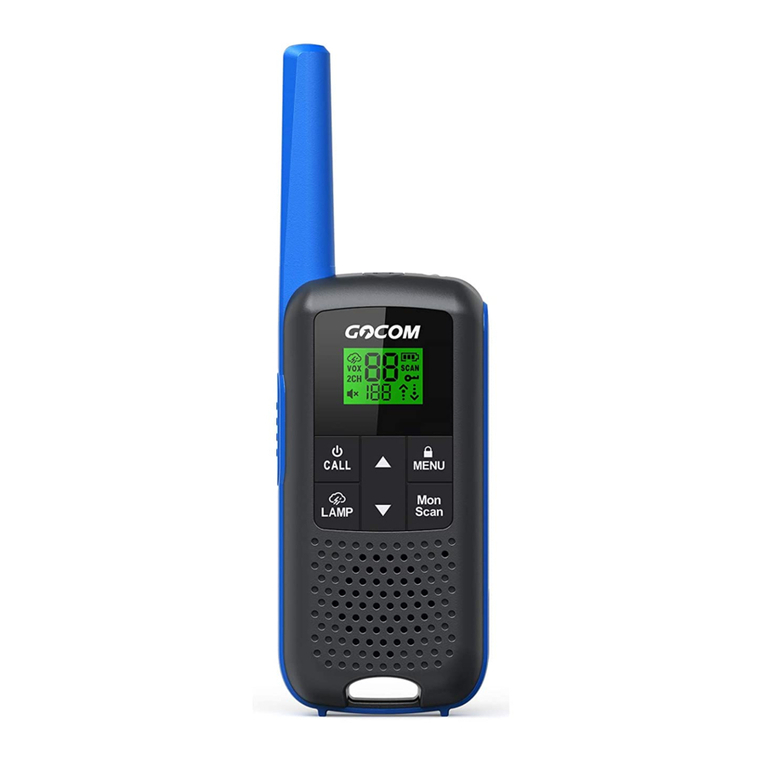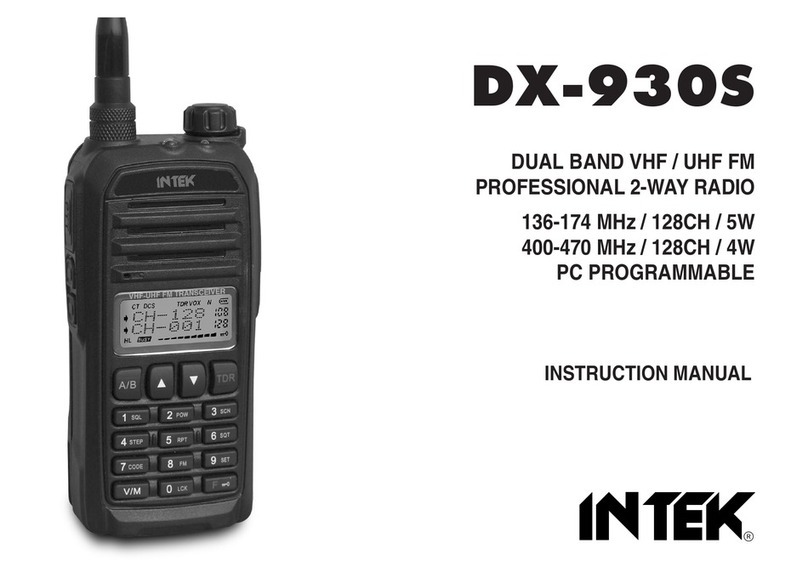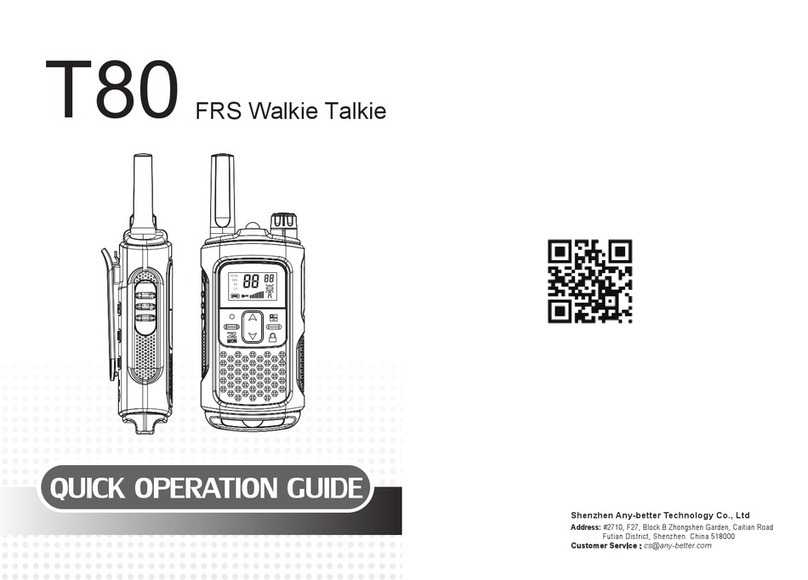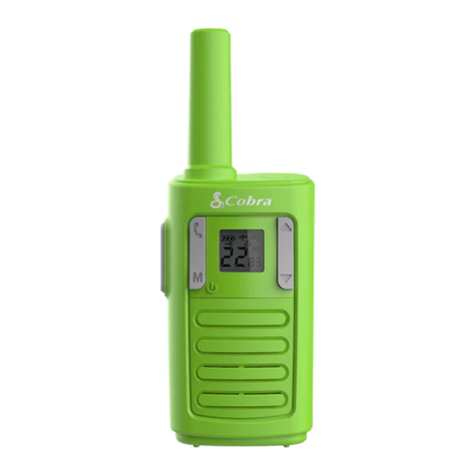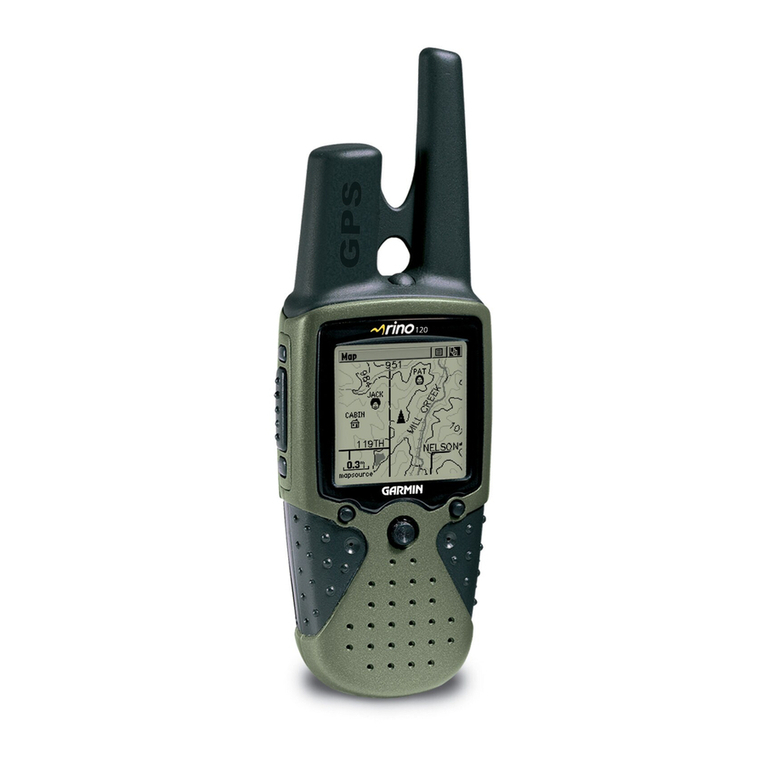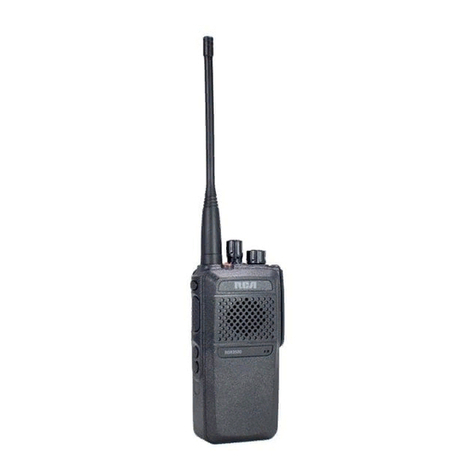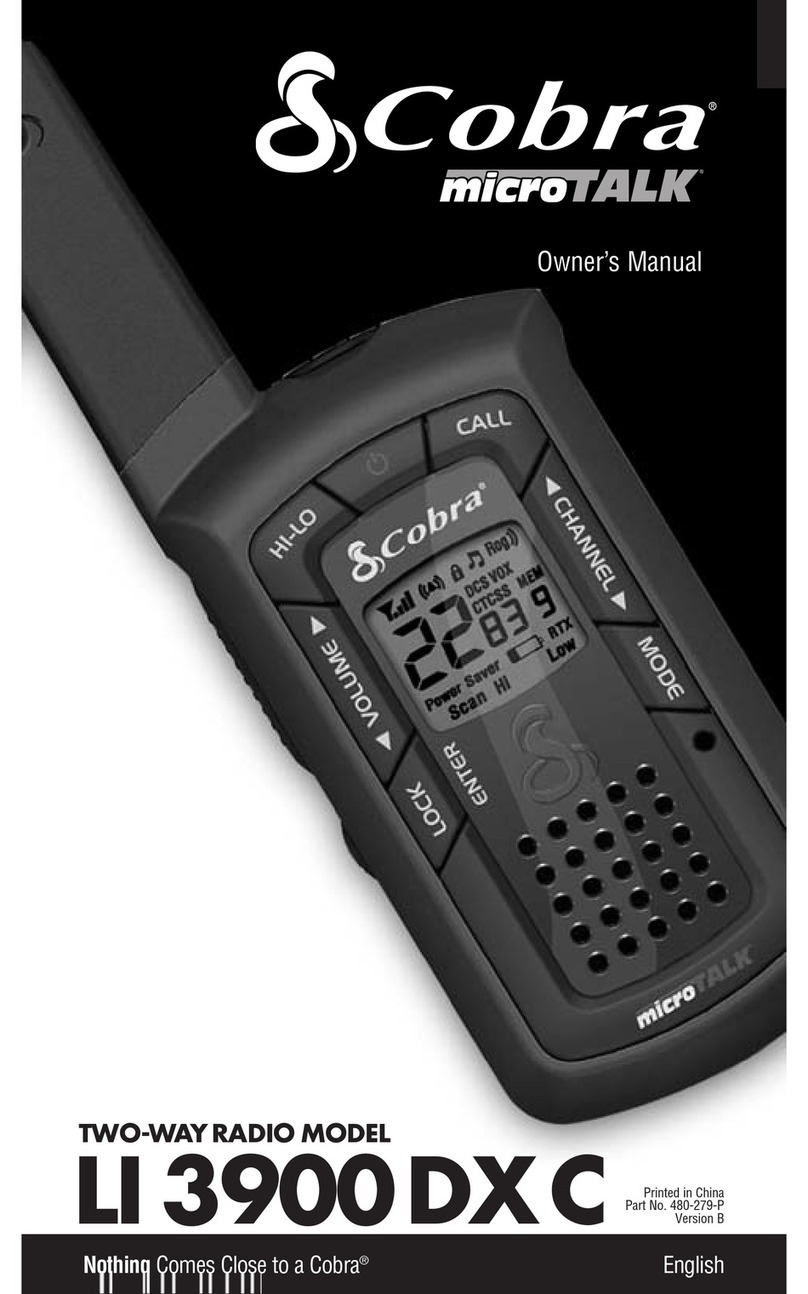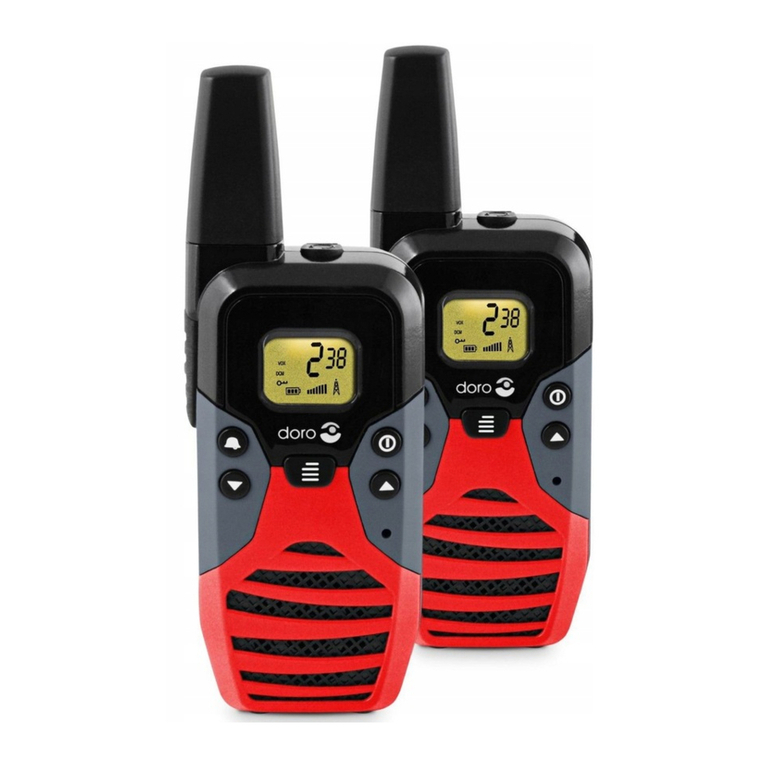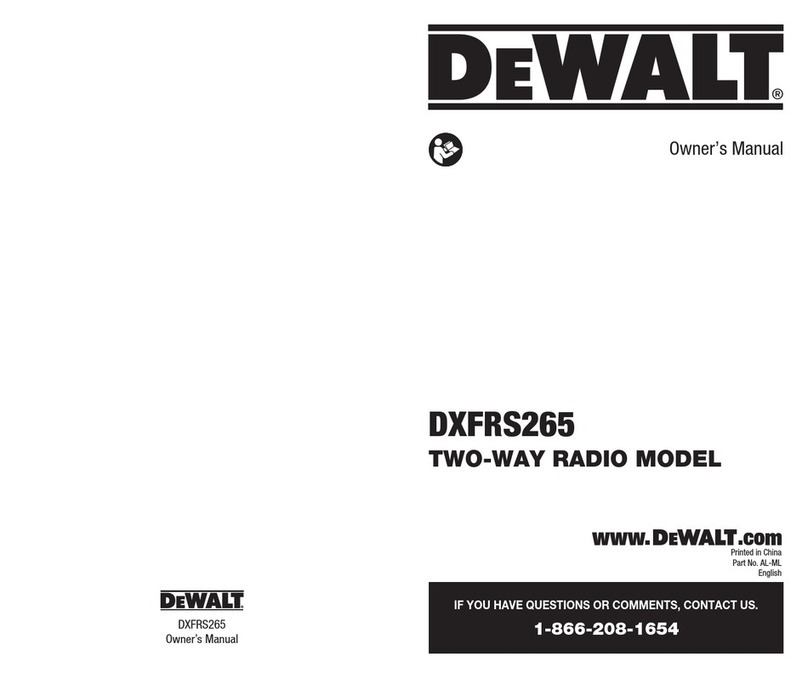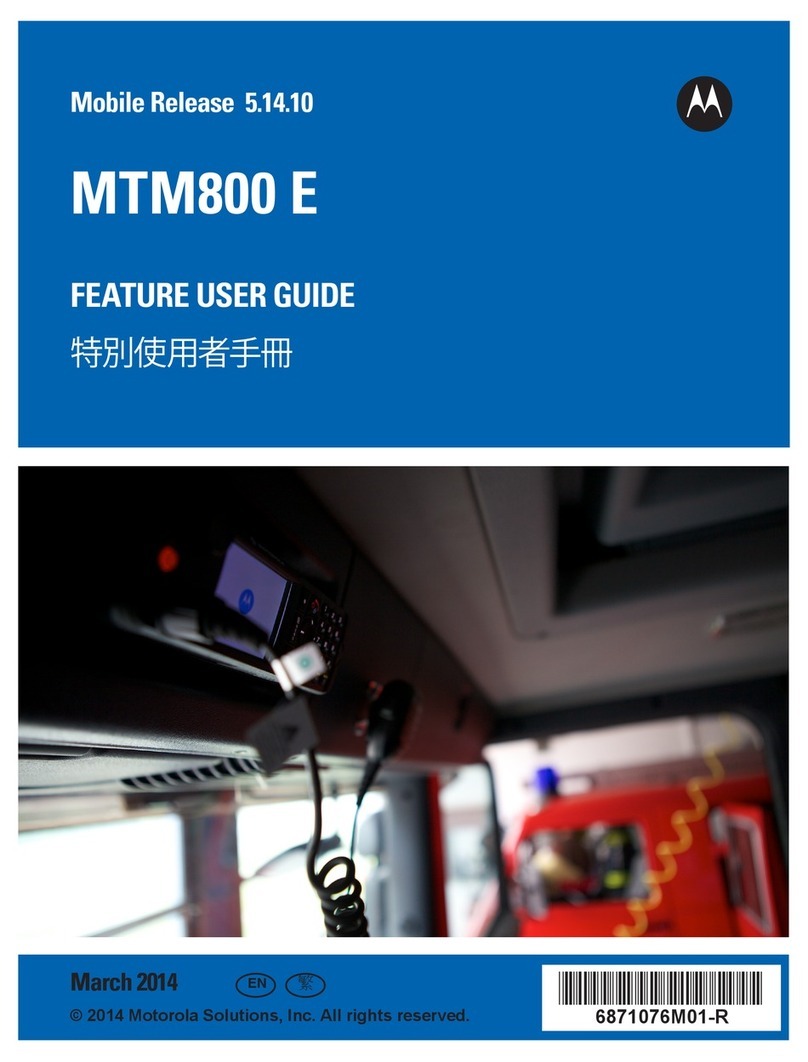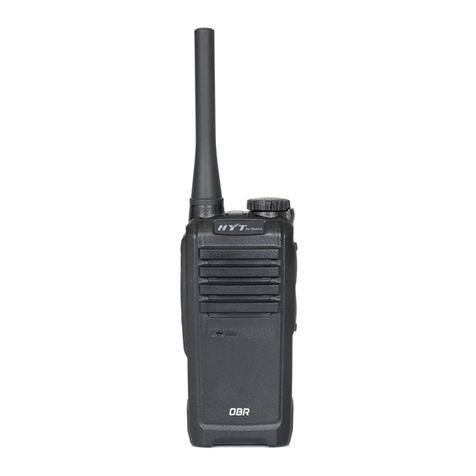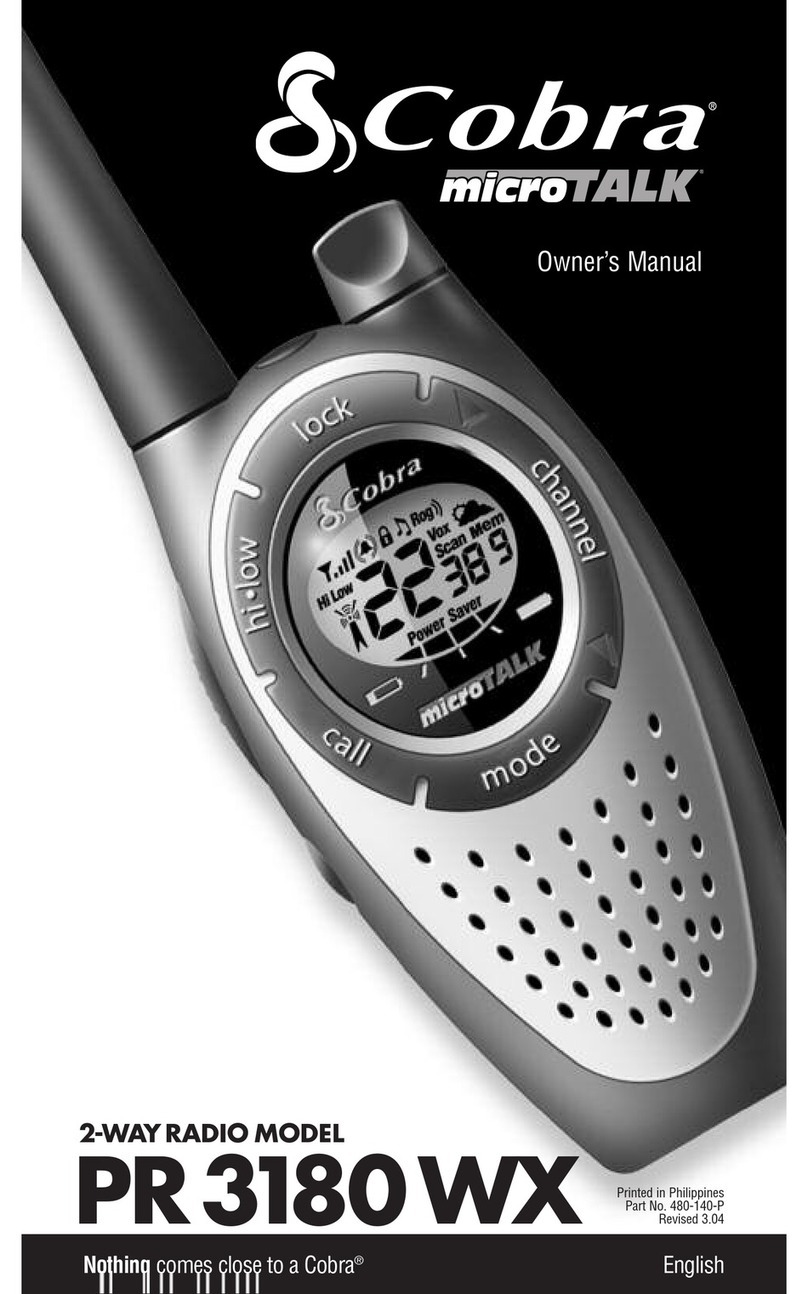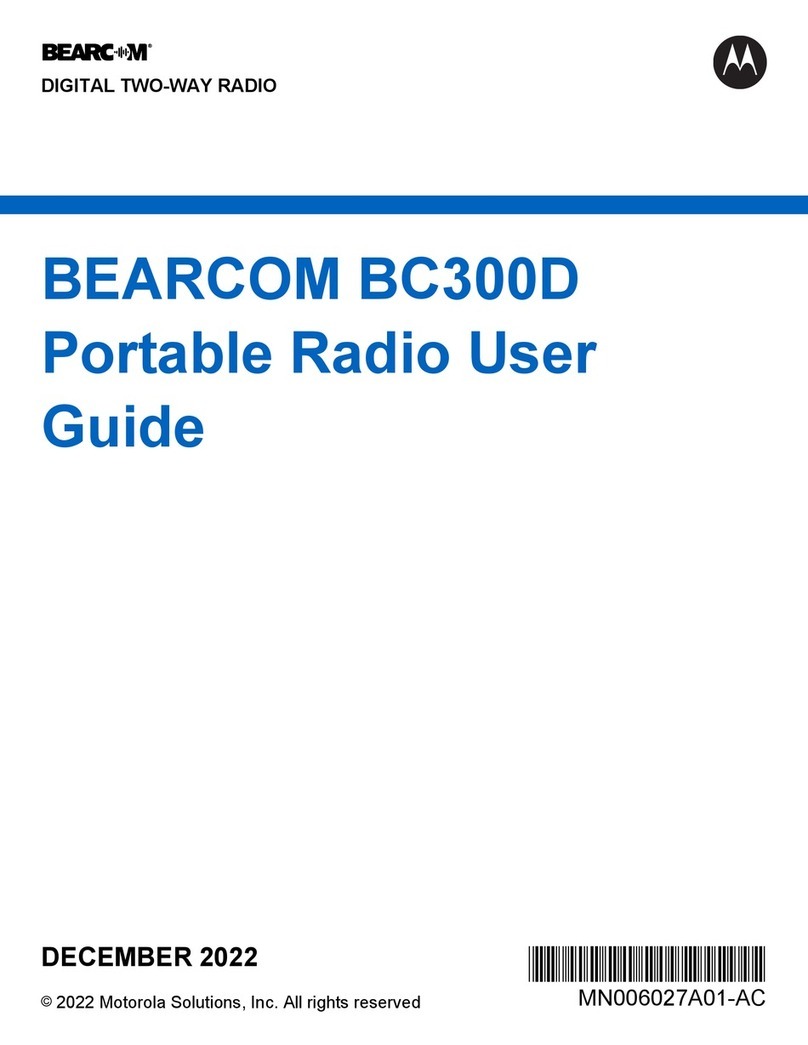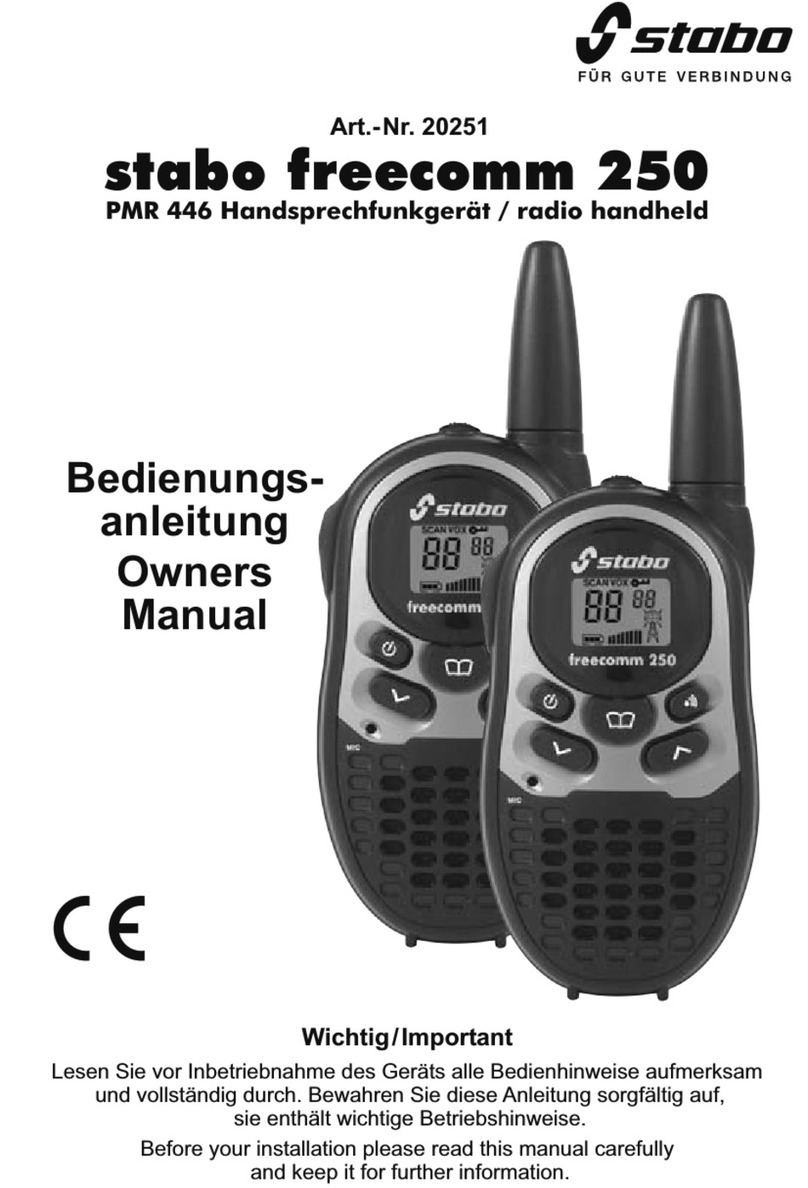Desighn2000 TACT TA-4800 User manual

Operator Manual for TACT TA-4800 in NSW National Parks & Wildlife Service User Mode G/00123B Issue 1
TACT TA-4800
Two-Way Radio/Telephone Interconnect
ACMA Supplier’s Code N468
ISO9001 Certified
NSW National Parks & Wildlife Service
User Mode
Document G/00123B
Issue 1, 09/08/2012
Design Two Thousand Pty Ltd ABN: 45 005 014 639
9-11 Rose Street
Upper Ferntree Gully
Melbourne Victoria 3156 Australia
Telephone: +613 9758 5933 Facsimile: +613 9758 5560
Email: gen@design2000.com.au
Web Site: www.design2000.com.au
All Rights Reserved,
Copyright Design 2000 Pty Ltd © 2012

________________________________________________________________________________________________
Operator Manual for TACT TA-4800 in NSW National Parks & Wildlife Service User Mode G/00123B Issue 1
BLANK PAGE

________________________________________________________________________________________________
Operator Manual for TACT TA-4800 in NSW National Parks & Wildlife Service User Mode G/00123B Issue 1
TACT TA-4800
TACT TA-4800 TWO WAY RADIO/TELEPHONE INTERCONNECT - 19” RACK MOUNT VERSION
Operator Manual - Document Number G/00123B (NSW NP&WS User Mode)
CONTENTS
INTRODUCTION PAGE
Features 1
Local and remote programming description 2
TACT Indicators and connectors 2
USING TACT
Making a telephone call 4
Receiving a telephone call 4
Speed dialing 4
Last number redial 4
Out-dial line select (other than default)
(Optional)
5
USER FEATURES
Recorded voice announcement 5
Called indicator 6
Call counter 6
System PIN 6
Hold 6
Two line operation 7
FACTORY OPTIONS
Alarm input 8
Alarm dialer 8
Auxiliary output relays 8
Paging 9
Paging speed dial 9
Hook flash 10
Local telephone 10
Call Barring 10
SYSTEM CONFIGURATION
System configuration codes 11
EPROM firmware version number 14
CONNECTION DIAGRAM 16
Connections 17
Audio level adjustments 19
Audio output to the radio (Tx) 19
Audio input from the radio (Rx) 19
Press to talk (PTT) output to radio 21
Carrier operated squelch (COS) input from radio 21
SUMMARIES
Summary of user codes 22
Specifications 25
Speed dial index 26
DESIGN TWO THOUSAND PTY LTD

________________________________________________________________________________________________
__________________________________________________________________________________________________________
Operator Manual for TACT TA-4800 in NSW National Parks & Wildlife Service User Mode G/00123B Issue 1 Page 1
TACT TA-4800 RADIO/TELEPHONE INTERCONNECT
INTRODUCTION
TACT, the Telephone Access Control Terminal, interconnects a two-way radio system to a telephone line or
PABX extension. It allows you to make and receive telephone calls on your two-way radio mobiles and
hand-helds. Other features include paging, alarm and telemetry facilities.
Design Two Thousand Pty Ltd, established in 1968, has been making TACT units since 1987, and this TA-
4800 is the new flagship model. It is the digital successor to the well-proven TA-7. Here you have the option
of dialing telephone numbers using the TA-4800 in the same way as the TA-7.
Things that make the new TA-4800 unique are full remote programmability without the need for a modem,
real voice prompts to the user, and the many advantages of digital signal processing.
FEATURES
Make and receive telephone calls as per the
TA-7
100 number speed dial
Last number redial
Manual patch facility
Digital recorded voice announcement
Digital personalised recorded voice
announcement
Called indicator
Call counter
Programmable PIN access
Local and Full Remote programmability
Two line capability
DTMF dialing
Dial tone detect
Exchange (CO) or PABX line
Programmable silence disconnect
Programmable call time limit
Busy tone detect
Line reversal detect
Loop current loss detect
Data mode
Programmable call barring
Call progress display
Hook flash (100 ms)
Priority outdial line (L1 default)
Call waiting on other line tone
Manual / auto answer for each line
Programmable ring delay for each line
Programmable repeater tail timer (COS
ignore after PTT release)
Programmable VOX attack time (Signal
detect count)
Programmable VOX sensitivity (Activate level)
Programmable VOX persistence (Hang timer)
Programmable Digital VOX audio delay
Programmable level adjustments
Simplex / half duplex/ duplex
Programmable tail defeat (radio VOX)
sensitivity & persistence
Repeater audio mode (strapable).
EPROM version number display
RS232 port for status messages,
programming and diagnostics
RS232 ports for modem & telemetry Interface
12V d.c. working. (Ground insensitive)
1 RU, 19” rack mountable enclosure
Two Year warranty
ACMA Supplier’s Code N468
OPTIONAL
Alarm input
Alarm dialer
Auxiliary output relays
Paging:
DTMF selcall
Two tone page (Quickcall)
Five / six tone page (Selcall)
Programmable Two tone paging plan letter
Programmable pre-coded paging digits
Programmable Five /six tone paging plan
Programmable paging parameters
100 paging and selcall memories
Emergency number dial mode
Programmable CTCSS (PL) Encode/Decode

________________________________________________________________________________________________
__________________________________________________________________________________________________________
Operator Manual for TACT TA-4800 in NSW National Parks & Wildlife Service User Mode G/00123B Issue 1 Page 2
LOCAL AND REMOTE PROGRAMMING
All user programmed data, system options and tone detection parameters can be verified or changed from
the inbuilt keypad. Programming is also possible from any telephone or radio on your system using DTMF
tones. TACT’s digitized voice synthesizer provides confirmation of programming changes and stored data.
Data retained in memory can also be interrogated and altered at higher speed using a PC.
User functions are easily selected by pressing the appropriate number keys. Access to reading or changing
system options requires access codes as detailed later in this handbook.
PROGRAMMING PROCEDURES
There are three programming levels that can be accessed:
1. Making and receiving telephone calls
2. User features
3. System configuration
1. From The Keypad
Simply press the required number keys as detailed in this handbook. Confirmation is displayed to the
user on the LED monitor.
2. From A Mobile Or Handheld Radio
The mobile radio must have a DTMF pad. Programming from the mobile is identical to that from the
keypad. The only difference is that programming information is reported by digitized voice prompts and
confirmation messages.
3. From The Local Telephone
Lift handset and programming is identical to that from a mobile.
4. From A Remote Telephone
Dial up TACT and wait for answer. You then dial a password and programming is identical to that from a
mobile.
TACT INDICATORS
Programming progress and success is displayed on the seven segment LED monitor display. (Remote
operation is prompted and confirmed by the voice synthesizer). The 7 segment monitor display also provides
call progress information:
0= silence
1= busy tone
2= modulated dial tone
3= Number Unobtainable (N.U.) tone
4= speech
5= continuous tone
6= indeterminate service tone
7= ringing tone
8= unmodulated ringing tone
9= random disconnect tone
n.
= DTMF (monitor display shows DTMF digits from radio only!)

________________________________________________________________________________________________
__________________________________________________________________________________________________________
Operator Manual for TACT TA-4800 in NSW National Parks & Wildlife Service User Mode G/00123B Issue 1 Page 3
In addition to the monitor display, visual indication of operating progress is provided by six LEDs on the front
panel marked ‘POWER’, ‘READY’, ‘CONNECT’, ‘ON AIR’ ‘Tx’, and ‘Rx’.
The ‘POWER’ LED indicates that power is connected and that the internal fuse is intact. The ‘READY’ LED
indicates that the system is ready for calls. The ‘CONNECT’ LED illuminates whenever the PSTN telephone
line(s) is ‘looped’. The ‘ON AIR’ LED illuminates whenever the audio path is open to the radio. The Tx and
Rx LEDs indicate transmit (PTT) and receive (COS) from the radio.
TACT CONNECTORS
12V nom. power input: BL-2 plug
Telephone line: RJ12
Second telephone line: RJ12
Radio: RJ45
RS232 Port RJ45 (Call Data /Diagnostics)
Please refer to ‘CONNECTIONS’ for connector details.
8.
CONNEC
T
TX
ON AIR RX
POWER
READY

________________________________________________________________________________________________
__________________________________________________________________________________________________________
Operator Manual for TACT TA-4800 in NSW National Parks & Wildlife Service User Mode G/00123B Issue 1 Page 4
MAKING AND RECEIVING TELEPHONE CALLS
Making a Telephone Call
1. Press * and listen for “bee-boo”.
2. Dial the required telephone number.
(If you make a mistake, press #, wait for “Error” and start dialing again).
3. Press *.
4. Listen for "TACT dialing"
5. Wait for answer, then proceed with conversation.
6. To end the call, press ##. Listen for "Line disconnected".
Receiving a Telephone Call
Manual Answer Mode
1. When a call comes in, you will hear a ringing sound over the radio “ring…ring…”.
2. Press * (in between the rings) to answer the call.
3. Listen for the “bee-boo” ‘Connect’ tone.
4. Proceed with conversation.
5. To end the call, press ##. Listen for "Line disconnected".
Note: The ringing sound will be distinctly different if a call comes in on line two.
Auto Answer Mode (default)
1. When a call comes in, you will hear the “bee-boo” ‘Connect’ tone or “Line connected”.
2. Proceed with conversation.
3. To end the call, press ##. Listen for "Line disconnected".
SPEED DIALING
Abbreviated dialing of up to 100 of your most frequently called telephone numbers.
To Store Speed Dial Numbers
1. Press *2.
2. Press xx, where xx is the required memory location (00-99).
3. Enter the required number.
Note that you may enter dialing pauses, * and # as part of the number. *# = dialing pause, ** = * and
## = #
4. Press #.
5. Listen for "The number is nnnnnnnn".
6. NOTE THE NUMBER DOWN IN THE SPEED DIAL INDEX (second last page).
7. To check the number in memory, press *2 xx #.
To Dial Speed Dial Numbers
1. Press #.
2. Enter required memory location (00-99).
3. Listen for "TACT dialing".
4. Wait for answer, then proceed with conversation.
5. To end the call, press ##. Listen for "Line disconnected".
LAST NUMBER REDIAL
1. Press # 0 within two seconds of each other.
2. Listen for "TACT dialing".
3. Wait for answer, then proceed with conversation.
4. To end the call, press ##. Listen for "Line disconnected".

________________________________________________________________________________________________
__________________________________________________________________________________________________________
Operator Manual for TACT TA-4800 in NSW National Parks & Wildlife Service User Mode G/00123B Issue 1 Page 5
OUT-DIAL LINE SELECT (OTHER THAN THE DEFAULT) AND THEN MAKE A CALL (OPTIONAL)
This allows you to make calls from Line 2 of TACT.
1. Press # n #, where n is 2 or 1 (line 2 or line 1).
2. Press * and listen for “bee-boo”.
3. Dial the required telephone number.
4. Press *.
5. Listen for "TACT dialing".
6. Wait for answer, then proceed with conversation.
7. To end the call, press ##. Listen for "Line disconnected".
Note: You can dial speed dial numbers by dialing # 00-99 instead of steps 2 & 3.
USER FEATURES
RECORDED VOICE ANNOUNCEMENT (OPTIONAL)
TACT can play a digitally Recorded Voice Announcement (RVA) to the telephone caller before the call is
directed to the field. The ‘RVA’ can be a standard announcement or a personally recorded announcement,
eg. “You are being connected to a two-way radio”. Please note that the personal announcement (PRVA)
only works when TACT is programmed for auto answer mode.
Recording Your Personalised Recorded Voice Announcement (PRVA)
The system allows you to record your own announcement of up to 60 seconds.
From a telephone, dial TACT, wait for answer and access remote programming mode with *67PIN#, then:
1. Press * 78 # and listen for the "Beep".
Immediately commence dictating your announcement clearly into the telephone. If you exceed 60
seconds, TACT will replay what has been recorded. If you want to re-record your announcement, repeat
step 1.
2. When recording is complete immediately press #. Your announcement will be replayed to you.
3. To review your announcement you can press * 79 #.
4. If you want to disable the personalised RVA, press * 78 # #. Your previous recording is also erased.
RVA Summary
* 78 # = record personalised announcement
# = stop recording
* 79 # = review personalised announcement
* 78 # # = Disable and erase PRVA

________________________________________________________________________________________________
__________________________________________________________________________________________________________
Operator Manual for TACT TA-4800 in NSW National Parks & Wildlife Service User Mode G/00123B Issue 1 Page 6
CALLED INDICATOR
If you leave your vehicle and incoming calls are not answered, TACT will register unanswered calls. You can
check this from the radio only.
To Read the Unanswered Call Indicator
1. Press * 30 # and listen for either "No calls" or "n calls", where n was the number of unanswered calls.
The unanswered calls register is then automatically reset.
CALL COUNTER
TACT automatically counts the number of calls connected to the field. You can read the call counter from the
radio only.
To Read the Call Counter
1. Press * 31 #. TACT responds "Call count nnnn".
To Reset the Call Counter
1. Press * 31 0 #. TACT responds "Call count 0000".
SYSTEM PERSONAL IDENTIFICATION NUMBER (SYSTEM PIN)
TACT can be programmed to operate only after a valid PIN has been entered. All users on the system are
required to insert the PIN before dialing or programming. It can prevent unauthorised use, and allow multiple
TACT units to be used on the same radio frequency.
To Program the System PIN
1. Press * # p…#, where p… is the required PIN (1 – 8 digits).
This number cannot be recalled, it can only be over-written.
HOLD
Placing a Call on Hold
1. Press *1.
To Take the Call off Hold
1. Press *1 (please wait a few seconds for the call to be returned).

________________________________________________________________________________________________
__________________________________________________________________________________________________________
Operator Manual for TACT TA-4800 in NSW National Parks & Wildlife Service User Mode G/00123B Issue 1 Page 7
TWO LINE OPERATION
To End a Call in Progress and Answer an Incoming Call on the Other Line
1. Press ##.
2. Press * 1.
To Hold First Call and Answer an Incoming Call on the Other Line
1. Press *1.
2. Press *.
Alternate between Calls on Hold
1. Press *2.
Conference Call (Not Yet Implemented)
1. Press *3.
To Hang up on the Last Person Spoken to and Return to the Other
1. Press ##.
2. Press *1 (please wait a few seconds for the call to be returned).

________________________________________________________________________________________________
__________________________________________________________________________________________________________
Operator Manual for TACT TA-4800 in NSW National Parks & Wildlife Service User Mode G/00123B Issue 1 Page 8
FACTORY OPTIONS
ALARM INPUT
Alarm systems such as a security alarm, a door open alarm or mains failure alarm can be connected to the
TACT alarm input (Pins 4 & 5 of the ‘ALARM’ connector). Should the alarm be triggered, TACT can:
i. Send an "Alarm activated" message to air (see ‘System Configuration’).
ii. Dial up to four telephone numbers and send an "Alarm activated" message to line (see below).
iii. Initiate a Page call.
iv. Activate auxiliary output relay one to perform an external function.
ALARM DIALER
TACT can perform the function of an alarm dialer. Up to 4 different telephone numbers can be dialed in
succession where the "Alarm activated" message is played to each number for thirty seconds. When you
receive an alarm call, you can press # to acknowledge the alarm and stop TACT from dialing any further for
that alarm.
To Enter the First Alarm Dial Number
1. Press * 81 x nnnnnnnnnn #, where x is the number of dial attempts and nnnnnnnnnn is the number to be dialed.
To Enter the Second Alarm Dial Number
1. Press * 82 x nnnnnnnnnn #, where x is the number of dial attempts and nnnnnnnnnn is the number to be dialed.
To Enter the Third Alarm Dial Number
1. Press * 83 x nnnnnnnnnn #, where x is the number of dial attempts and nnnnnnnnnn is the number to be dialed.
To Enter the Fourth Alarm Dial Number
1. Press * 84 x nnnnnnnnnn #, where x is the number of dial attempts and nnnnnnnnnn is the number to be dialed.
To Erase a Number
1. Enter a single ‘0’ in place of x nnnnnnnnnn as detailed just above.
AUXILIARY OUTPUT RELAYS (OPTIONAL)
The Auxiliary Output Relays can be connected to most switchable systems. This provides for the control of
sirens, security systems, power gates, electric door strikes and more. The relay(s) can remain latched,
automatically reset, or automatically be activated by certain events. See page 17 for connection details.
To Operate the Relay One
1. Press * 07 1 #. Listen for "Relay one operated".
To Interrogate the Relay One State
1. Press * 07 #. Listen for "Relay one operated" or "Relay one idle".
To Reset the Relay One
1. Press * 07 0 #. Listen for "Relay one idle".
To Operate the Relay Two
1. Press * 08 1 #. Listen for "Relay two operated".
To Interrogate the Relay Two State
1. Press * 08 #. Listen for "Relay two operated" or "Relay two idle".
To Reset the Relay Two
1. Press * 08 0 #. Listen for "Relay two idle".

________________________________________________________________________________________________
__________________________________________________________________________________________________________
Operator Manual for TACT TA-4800 in NSW National Parks & Wildlife Service User Mode G/00123B Issue 1 Page 9
PAGING
Pagers, mobiles and handhelds with paging decoders can be selectively called from any DTMF telephone or
from a mobile with a DTMF pad. TACT can encode most two tone (quickcall) and five tone (selcall) paging
protocols. Paging plans and parameters are field programmable but best specified at the time of ordering.
TO INITIATE A PAGE CALL
Two Tone Page Call (Quickcall)
1. Press * 72 nn #, where nn is the two tone number.
Five Tone Page or Selective Call (Selcall)
1. Press * 75 nnnnn #, where nnnnn is the five tone number.
PAGING SPEED DIAL
A combination of up to 99 two tone and/or five tone numbers can be stored in memory. This enables
abbreviated speed dialing of two tone paging (quickcalls) and five tone paging (selcalls).
To Store Two Tone Page Numbers in Memory
1. Press * 42 nnn # xx, where nnn is the two tone page number and xx (01-99) is the memory location.
To Store Five Tone Page Numbers in Memory
1. Press * 45 nnnnn # xx, where nnnnn is the five tone page number and xx (01-99) is the memory
location.
To Speed Dial a Two Tone or Five Tone Paging Call from Memory
1. Press * 4 xx #, where xx is the memory location. Listen for paging tones.

________________________________________________________________________________________________
__________________________________________________________________________________________________________
Operator Manual for TACT TA-4800 in NSW National Parks & Wildlife Service User Mode G/00123B Issue 1 Page 10
HOOK FLASH
A Hook flash (also called ‘Recall’ or timed loop break) is used to facilitate PABX and electronic exchange
functions such as transfer, hold and recall.
For TACT To Generate a Hook Flash (Timed Loop Break)
1. Press * 6.
LOCAL TELEPHONE (OPTIONAL)
The local telephone is a ‘master terminal’ that can be used as a monitor, a paging terminal, a central point of
contact for field units, a terminal to place calls for mobiles and a terminal to intercept and screen incoming
calls to be patched through to the field. In addition, field units can contact the office staff by ringing the local
telephone. Telephone calls on the local telephone can either be private or broadcasted.
Calling the Local Telephone from a Mobile
1. Press * 90 #.
Calling a Mobile from the Local Telephone
1. Lift handset and voice call or page mobile.
To Turn On Local Telephone Privacy Mode
1. Press * 91 1 #.
To Turn Off Local Telephone Privacy Mode
1. Press * 91 0 #.
All other programming from the local telephone is identical to that from a mobile or remote telephone.
CALL BARRING (Not yet implemented)
The only easy way of restricting mobile users from dialing outside local or long distance numbers is to limit
the number of digits that they are allowed to dial. Please note that emergency numbers are always allowed
(000, 111, 911, 112, 999, etc.). For more comprehensive call barring, use the barring facilities of your PABX
or your telephone company.
To Set the Number of Digits that can be dialed from a Mobile
From the Keypad of TACT only:
1. Press * 59 nn #, where nn can be 00-24.
2. To check the number of digits allowed, press * 59 #.

________________________________________________________________________________________________
__________________________________________________________________________________________________________
Operator Manual for TACT TA-4800 in NSW National Parks & Wildlife Service User Mode G/00123B Issue 1 Page 11
SYSTEM CONFIGURATION
Programming can be done from the TACT inbuilt keypad, remote telephone or radio.
The programming is the same from the keypad, remote phone or the serial port. An extra two steps are
required when accessing programming from a phone or radio. After connection, type *67PIN#
(where the default PIN = 1234) to enter programming mode. To exit remote programming mode press
#*#.
1. Press *6703# to enter system configuration programming mode.
2. Press *nn, where nn is the required option number from the table below.
TACT then reports the selected option number and its current status.
3. Enter a new value as required.
TACT then reports the option number and its new status.
4. Press *# to save and exit, OR
Press # to scroll to the next option OR
Press *nn, where nn is another required option number from the table below.
5. Enter a new value as required.
TACT then reports the selected option number and its new status.
6. Press *# to save and exit (or press ** to abort all changes)
Command Summary
*6703#
* nn where nn is option number
n… = entry
# = scroll
* * = abandon
* # = store & end
OPTION CODES
Code Function Range Default Description
*01 Reversal On Idle Ignore
Incoming telephone Calls
0,1 0 0 = enable CPC detection
1 = disable CPC detection
*02 Reversal On Idle Ignore
Outgoing Calls
0,1 0 0 = enable CPC detection
1 = disable CPC detection
*03 Reversal On Answer Ignore 0,1 0 0 = enable ROA detection
1 = disable ROA detection.
NOT USED.
*04 Decadic Dialing 0,1 0 0 = DTMF
1 = Decadic
NOT USED
*05 Dial tone Ignore 0,1, 2-9 1 0 = dial out as soon as dial tone is detected. If no
dial tone within 4 seconds, hang up.
1 = dial out as soon as dial tone is detected. If no
dial tone within 2 seconds, dial regardless.
n = Ignore dial tone and dial after n seconds,
where n = 2 – 9.
*06 Delay After First Digit for
‘outside’ access
0,1 0 0 = no delay
1 = 2 second delay after first digit when dialing.
*07 Loop Break on silence 0,1 0 0 = no loop break
1 = momentarily hang up phone line when silence
detected for 20 seconds on an incoming call.
NOT IMPLEMENTED
*08 Digit Limit 00-21 21 21 = maximum digit limit
other = max number of digits that can be dialed
by TACT
*09 Hook flash Time 0-3000 0100 ms for hook flash

________________________________________________________________________________________________
__________________________________________________________________________________________________________
Operator Manual for TACT TA-4800 in NSW National Parks & Wildlife Service User Mode G/00123B Issue 1 Page 12
*10 Manual/Auto Answer - Line 1
(See *36 for Line 2)
0,1,2,3 2 0 = Auto Answer
1 = Manual Answer
2 = Delayed auto answer
3 = PTT to answer
*11 Answer Delay 0-255 002 Seconds before auto answering a call or sending
ring tone to radio. Also used to set delayed auto
answer time
*12 Ring Voltage Gap 0-9 5 Seconds maximum gap in ringing voltage.
*13 Absolute signal level detect
(Line VOX minimum activate
level)
0-255 080 qdB. Minimum detect threshold for telephone
lines. Bigger is less sensitive
*14 CTCSS encode 00-50 00 The CTCSS tone to use for this line.
NOT IMPLEMENTED
*15 Silence Disconnect 0-255 001 Minutes of silence to disconnect phone line.
Could be used for no Tx timeout
*16 Total call time limit 0-255 002 Minutes total call time limit
NOT IMPLEMENTED
*17 Continuous tone disconnect 000-255 010 Seconds of continuous tone before disconnection.
000 = continuous tone allow & for fax data
*18 Malicious call trace 1,2 1 1 = normal
2 = hook flash on incoming call.
NOT IMPLEMENTED.
*19 PIN required on phone line to
access radio
0,1 0 0 = normal
1 = PIN required to access radio
Must not be in manual answer mode.
*20 Who Called Enabled 0,1 0 0 = normal operation
1 = invite to leave who called info
NOT IMPLEMENTED
*21 Two Tone (Quickcall) Plan 00-20 16 (S) Motorola two tone paging plan. 0=A,
1=B etc no I or Q
*22 Two tone precoded digits up to 2 None precoded digits preceding a two tone page
*23 Five Tone (Selcall) Plan 0-3 1 0 = EIA
1 = CCIR
2 = EEA
3 = ZVEI
*24 Five Tone tone period 0-3000 0040 ms tone period when paging
*25 Lead in period 0-3000 0500 ms from PTT to page send.
*26 Silence gap 0-3000 0045 ms gap between preamble tone and five tone page
*27 Preamble Tone 0-11 12 five tone preamble, 12 = 0ff
*28 Preamble Tone Length 0-3000 0000 five tone preamble duration
*29 Five Tone precoded digits up to 5 None digit prefixed to a five tone page. Press # after
entering less than 5 digits
*30 Preferred line 0,1 0 Preferred out-dialing line.
0=line 1
1=line 2
*31 Call waiting tone 0,1 0 0 = no call waiting tone
1 = call waiting tone
AUTOMATIC
*32 Radio Busy Indicator 0,1 0 0 = no answer when radio busy
1 = message when radio busy
NOT IMPLEMENTED
*34 Voice Prompts 0-2 1 0 = voice prompts to radio and phone
1 = beeps to radio and phone
2 = just beeps to radio but no beeps to phone line
*36 Manual/Auto Answer – Line 2
(See *10 for Line 1)
0,1,2,3 0 0 = Auto Answer
1 = Manual Answer
2 = Delayed auto answer
3 = PTT to answer

________________________________________________________________________________________________
__________________________________________________________________________________________________________
Operator Manual for TACT TA-4800 in NSW National Parks & Wildlife Service User Mode G/00123B Issue 1 Page 13
*40 Radio Mode 1-4 3 (0=OFF)
1 = Simplex
2 = Tail Defeat
3 = Half Duplex
4 = Full Duplex
5 = MAP27
*42 Digital VOX Audio Delay
0-1000 0000 ms of audio delay after keying transmitter.
(Prevent syllable loss from telephone party)
*43 COS Ignore after PTT off
(Repeater tail ignore) in VOX
slam-back mode only
0-3000 0420 ms ignore COS after PTT released.
(ms from PTT off until COS recognized to
prevent oscillation between Tx and Rx)
*44 Interconnect Facility Disable 0,1 0 0 = TACT Interconnect facility enabled
1 = TACT Interconnect facility disabled
NOT IMPLEMENTED
*45 Redial Busy 0,1 0 0 = terminate on busy number
1 = redial busy number
NOT IMPLEMENTED
*46 Alarm Dialer 0,1 1 0 = no alarm dialer
1 = alarm dial on alarm input (number(s) must be
programmed – refer to ‘Alarm Input’)
*47 Remote On Off 0,1 0 1 = normal
2 = allow remote control on/off
NOT IMPLEMENTED
*48 Unanswered call indicator 0,1 0 0 = normal
1 = allow caller to leave number
NOT IMPLEMENTED
*49 Aux 1 output relay mode 0-5 1 0 = OFF
1 = on for 2 seconds
(NOT while button pressed)
2 = latch on or off
3 = on for 8 minutes
4 = follow alarm input
5 = on while telephone line 1 is looped
*50 Aux 2 output relay mode 0-5 1 0 = OFF
1 = on for 2 seconds
(NOT while button pressed)
2 = toggle on or off
3 = on for 8 minutes
4 = follow alarm input
5 = on while telephone line 2 is looped
*51 Alternate LEDS 0,1 0 0= normal
1 = alternate LED functions
*52 Error Number 0,1 0 0 = no error number
1 = error numbers
NOT IMPLEMENTED
*53 Emergency Dial Delay 0-60 00 Seconds for emergency dial to occur
NOT IMPLEMENTED
*54 Alarm Message to Air Repeat
Timer
0-65 60 Seconds between alarm message to air
0 = Once to Air only without siren
*55 PRVA allowed 0,1 0 0 = no PRVA
1 = PRVA
NOT IMPLEMENTED
*56 DTMF Rx min on detect 0-255 040 ms of DTMF before detection
*57 DTMF Rx max off detect 0-255 040 ms gap in DTMF before absence
*58 COM baud rate 0-5 3 0 = 1200
1 = 2400
2 = 4800
3 = 9600
4 = 19200
5 = 38400
*59 COM1 baud rate 0-5 3 Ditto
*60 COM2 baud rate 0-5 3 Ditto

________________________________________________________________________________________________
__________________________________________________________________________________________________________
Operator Manual for TACT TA-4800 in NSW National Parks & Wildlife Service User Mode G/00123B Issue 1 Page 14
*61 Gain line 1 to line 2 000-030 dB Gain from line 1 to line 2.
NOT USED.
*62 Gain line 2 to line 1 000-030 dB gain from line 2 to line 1.
NOT USED
*63 PIN to make call 0,1 0 0 = no PIN
1 = PIN required to make call.
*64 PIN required to receive call in
manual answer mode
0,1 0 0 = * to answer call
1 = PIN to answer call
*65 ID required after PIN entry 0,1 0 0 = PIN can immediately be followed by number
or command
1 = user must wait after PIN for TACT ID
*66 Confirm manual number 0,1 0 0 = Dial after number entry
1 = Announce before dial
NOT IMPLEMENTED
*67 Line VOX Hang time
(VOX persistence)
0-1000 0100 PTT hold after line VOX de-activates and audio
delay is empty
*68 COS detect filter 0-1000 0100 ms how long a drop out is allowed in the COS
signal.
*69 Line VOX detect window
(VOX sensitivity) – see *13
also
0-15 12 20ms xx size of line VOX window. Increasing
the window size increases sensitivity.
*70 Line VOX count
(VOX attack time)
0-15 05 How many signal samples in line VOX Detect
Window for VOX activation. Number must be
less than VOX Detect Window. Decreasing the
count quickens attack time.
*71 Analogue radio transmit gain
(Line Radio Analog Tx Gain)
0-42 15 dB analogue Tx gain from phone to mobile radio
21 = 0dB
*72 Analogue radio receive gain
(Radio Line Analog Rx Gain)
0-42 18 dB analogue Rx gain from mobile radio to phone
21 = 0dB
*73 Digital gain radio to line
(Radio Line Digital Rx Gain)
0-99 46 dB digital Rx gain from radio
50 is 0dB
*74 Digital gain line to radio
(Line Radio Digital Tx Gain)
0-99 50 dB digital Tx gain to radio
50 is 0dB
*75 COS Sense 0,1 0 0 = COS active low
1 = COS active high
*76 Noise upper limit 0-255 100 qdB steps, sets upper limit for noise filters.
*77 COS Threshold 000
1-255
000
128
000 = digital (binary) input OR,
Voltage reference relative to 5V.
(128 = centre of COS swing 0 5V)
*78 No Rx (COS) from radio
disconnect timer
1-255 060 s. How soon radio must transmit to line for
connection to line to remain established.
*79 Radio VOX detect window
(Radio VOX Sensitivity)
0-15 12 20ms xx size of radio VOX window. Increasing
the window size increases sensitivity.
*80 Radio VOX count
(Radio VOX Attack Time)
0-15 03 How many signal samples in radio VOX Detect
Window for VOX detection.
Must be less than VOX Detect Window.
Decreasing the count quickens attack time.
*81 Radio Absolute signal level
detect (Radio VOX minimum
activate level)
0-255 050 qdB. Minimum detect threshold for Radio. Bigger
is less sensitive
*82 RS232 Modem COM Port
Functionality
0,1 0 0 = RS232 COM port operation for modem
1 = Alarm Input operation with AI-4775
*83 Permanent Line Connection
b/w two TACT units
0,1,2 0 0 = No permanent line connection
1 = MASTER permanent connection
2 = SLAVE permanent connection
*84 User Mode 0,1 1 0 = TA-4800 method of dialing phone numbers
1 = TA-7 method of dialing phone numbers
*85 VOX Override 0,1 0 0 = normal VOX operation
1 = DTMF 1 from phone forces PTT (Tx) and
DTMF 2 from phone releases PTT (Tx).

________________________________________________________________________________________________
__________________________________________________________________________________________________________
Operator Manual for TACT TA-4800 in NSW National Parks & Wildlife Service User Mode G/00123B Issue 1 Page 15
*86 MAP 27 PTT Type 0,1 0 0 = Standard Mic PTT
1 = SRM9000 Option PTT
*# Save and exit - - Save changes and exit
Please note the following:
If you make changes to the above parameters, you will need to restart TACT by removing and then
reapplying power before the changes will take effect.
Abbreviations:
ms = milliseconds dB = decibels
s = seconds qdB = quarter decibels
M = minutes
EPROM (FIRMWARE) VERSION NUMBER
The firmware version reveals the vintage and features available with your TACT.
1. Press *48# on the TACT keypad to read back the EPROM version number.

________________________________________________________________________________________________
__________________________________________________________________________________________________________
Operator Manual for TACT TA-4800 in NSW National Parks & Wildlife Service User Mode G/00123B Issue 1 Page 16
CONNECTION DIAGRAM
TELEMETRY I/F
Rear View
Front View
POWER
12 - 48V DC
RS232
LINE
PSTN
OR
PABX
RADIO
WIND SPEED
WATER LEVEL
TEMPERATURE
DC POWER
BATTERY VOLT
S
CABINET TEMP
ETC
ALARM INPUT
TELEPHONE
RS232
RELAY 1 OUT
POWER
12-48V DC
POLARITY
INSENSITIVE
RADIO/TELEPHONE INTERCONNECT
LINE 1
A
CA
SUPPLIER’S
CODE N468
SERIAL No.
LINE 2
RADIOALARM MIC PC MODEM
RS232
CONNECT
ON AIR
Tx
Rx
POWER
READY
ALARM
&
AUX RELAY
RELAY 2 OUT
MOBILE
TELEPHONE
MIC

________________________________________________________________________________________________
__________________________________________________________________________________________________________
Operator Manual for TACT TA-4800 in NSW National Parks & Wildlife Service User Mode G/00123B Issue 1 Page 17
CONNECTIONS
RADIO (RJ45)
The radio interface connection
PIN DESCRIPTION
1 PTT Common
2 PTT Normally Open
3 MAP 27 (Digital) Out
4 COS Indication from Radio
5 MAP 27 (Digital) In
6 Signal Ground (Return) (OV)
7 Audio Out from TACT to Radio (Tx)
8 Audio In to TACT from Radio (Rx)
TELEPHONE
LINE 1 (RJ12)
PSTN line or PABX extension connection
PIN DESCRIPTION
1
2
3 Ring (Lb)
4 Tip (La)
5
6
LINE 2 (RJ12)
An optional second PSTN or PABX Line connection
(sometimes an internal PABX extension)
PIN DESCRIPTION
1
2
3 Ring (Lb)
4 Tip (La)
5
6
Table of contents
